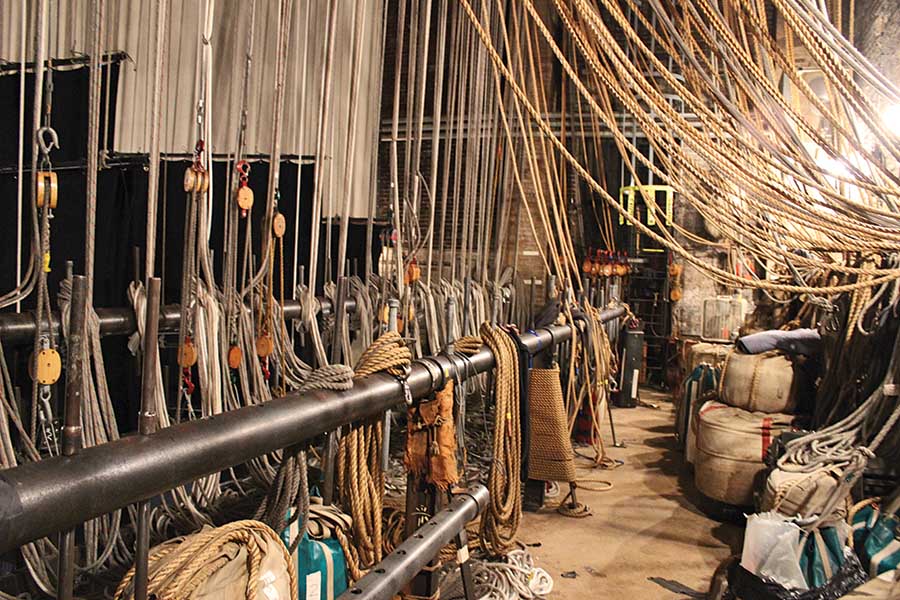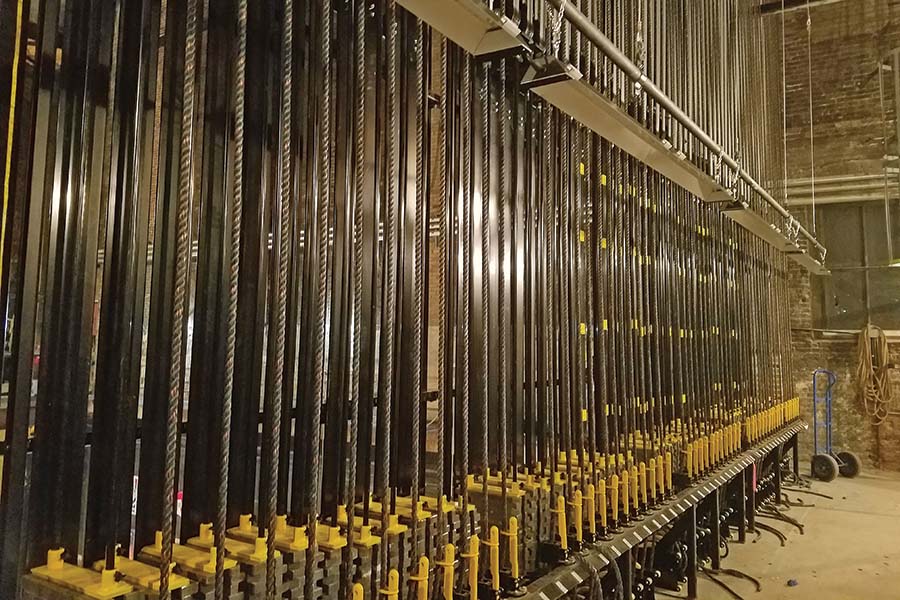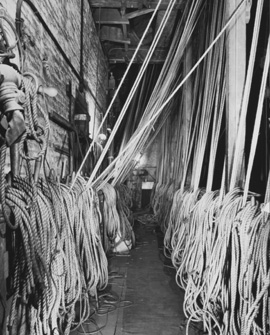Source: americantheatre.org

The National Theatre in Washington, D.C., recently replaced its hemp-and-sandbag system, pictured above, with a counterweight system.
How modernization and automation are rendering a once-common rigging system a historic relic.
In 1991, I was on staff at New York City’s Theatre for a New Audience when founding artistic director Jeffrey Horowitz and his team produced a revival of Romeo and Juliet at the Victory Theater on West 42nd Street. I remember being in that huge, musty theatre with the company for the first time. The Victory dated back to 1900, yet the young, energetic actors ran around the place like it was their own personal playground, climbing to various levels and remarking on the theatre’s historic details.
With a sense of awe and excitement, someone told me that this was one of only a few “hemp houses” left in the country, and maybe even the world. I had no idea what a “hemp house” was. The first thought that came to my mind was smoking hemp (a.k.a. cannabis—not that I ever did), and there were plenty of jokes going around about it. (Hemp has been illegal to grow in the U.S. since the 1970 Controlled Substances Act.) Eventually, I figured out that the theatre’s rigging ropes, which were run over pulleys and tied to sandbags, were made of this naturally derived fiber, as opposed to the durable synthetic rope or steel cable of today’s manual steel plate counterweight or motorized rigging systems.
Our show would be the last to be presented in the historic Victory. When the Victory was renovated as part of the New 42nd Street project, the hemp system was replaced with a counterweight fly system. The theatre reopened in 1995 as the New Victory that is presently in operation.
Today, even fewer young people know what a hemp house is than when I learned about them a quarter century ago. Most college theatres have motorized rigging systems, because “college students are often not trained well enough to safely operate manual counterweight rigging systems,” said veteran Broadway technical consultant Fred Gallo, president of PRG Scenic Technologies (Production Resource Group STNY). According to a 2013 article in Spotlight, the newsletter of NYC’s Local 1 of the International Alliance of Theatrical Stage Employees (IATSE), the stagehands union, only nine of the existing 41 Broadway theatres (most of which were built in the early 20th century) remain hemp houses. And the smallest Broadway theatre, the Helen Hayes, which was bought by the nonprofit Second Stage Theater in 2015, is currently undergoing a $22 million renovation, which will include replacing their hemp-and-sandbag system with counterweights, reducing the grand total of Broadway hemp houses to eight. Seven of them are owned by the Shubert Organization, which owns the most Broadway theaters (17).
“The ability to rig in a hemp house is a dying art,” Jennifer Diaz, the first female head carpenter of IATSE’s Local 1, who frequently works at Jujamcyn’s Walter Kerr Theatre (a hemp house), told The New York Times in October 2016.
It’s not just in New York. Around the country, historic theatres are regularly being remodeled and modernized, meaning that this historic rigging system is also being phased out regionally. The National Theatre, a presenter in Washington D.C., opened in 1835, and is the nation’s second oldest continuously operating theatre. It completed its work to replace the antiquated hemp-and-sandbag system with a more modern (though still manual) counterweight system in September.
Executive director Sarah K. Bartlo-Chaplin reports that they had identified $15 to $20 million worth of infrastructure work that could be done to improve and modernize the historic theatre, but decided to concentrate on converting the rigging system first because it impacted operations the most, constituting as much as 30 percent of their labor bill. “It made presenting smaller shows in our 1,700-seat house prohibitively expensive,” she explained.
While there is nostalgia around this important piece of theatre history, everyone—including the stagehands—has come to realize that more and more touring companies are not familiar with the hemp-and-sandbag system and have very little if any experience working in it. But to preserve that history and knowledge, the folks at the National are wisely archiving pieces of the system to someday make a display of formerly operating hardware, such as block-and-tackle and sandbags. In addition, Bartlo-Chaplin said, “We engaged both an archival photographer and artistic photographer to take pictures that honor the history of the hemp house, and we also made a GoPro video of the whole replacement project.”
State Theatre New Jersey in New Brunswick, also a presenter, likewise has a backstage crew who are proud of its 95-year-old hemp-and-sandbag system, although management is considering replacing it for the same reasons the National replaced theirs. Head carpenter Michael Sivetz, who started working with his father at the State when he was 18 years old in 1993, said that when Broadway touring shows arrive, “Sometimes the guys coming off the trucks take one look at our sandbags and groan, ‘Oh, no.’”

The National Theatre’s counterweight system.
While hemp houses have deep stages, they cannot hang as many set pieces as theatres with modern counterweight systems because, since the bulky sandbags require a lot more space, those theatres have fewer “line sets” from which to hang. A counterweight system might have a line set every 6 to 8 inches, but a sandbag system requires more than double the amount of space between rope sets. At the State, if a tour comes in with four or more 53-foot trucks, often less than half of the scenery can make it onto the stage because of the limited number of line sets.
“I also work at four newer, large arenas, and their manual counterweight systems are much more efficient,” said Sivetz. “They also have a higher weight capacity.” Indeed, Broadway touring sets like the ones that come through the State are getting heavier and heavier, but one of the State’s hemp line sets has a maximum of just 450 pounds, as opposed to a counterweight system that could support as much as five times that weight. “Nowadays, even a drop can weigh more than 450 pounds if it has fiber optics and electrics in it,” explained Sivetz.
As part of our interview, Sivetz let me climb up the 30-foot iron ladder to the grid above. I think he actually went out and got lunch while I was climbing; I was only halfway up when he got back. After I finally alighted, he zipped up the ladder and showed me around. I was slightly dizzy at that height, but he told me that the grid at the Barclays Center in Brooklyn is an average of 137 feet high. “Do you have to climb a ladder that far up?” I asked. “No,” he replied. “There’s an elevator.”
He showed me many elements specific to a hemp house, such as a “Sunday rope” (so-called because it’s tied after the show on Sunday to secure lines that would not be in use again until the next show on Tuesday), a clew (each line set has one that lets you control all five lines of a line set at once), loft blocks and head blocks (pulleys), and many more other details than I could retain. One piece of equipment I did recognize, though, was the old bathroom scale they use to weigh the sandbags.
I decided to compare how long it took me to climb back down the ladder (1 minute, 23 seconds) versus how long it took him to descend (17 seconds).

Hemp ropes at the Walnut Street Theatre.
The country’s oldest continuously operating theatre, the Walnut Street Theatre in Philadelphia, opened in 1809. Its website states that the facility “is one of only a few remaining ‘hemp houses’ in the country” that “continues to operate the original grid, rope, pulley, and sandbag system that was in use nearly two centuries ago.”
However, according to president and producing artistic director Bernard Havard, they no longer use the hemp ropes exclusively. “Because we are a producing theatre, our sets stay up a minimum of eight weeks, as opposed to presenting theatres, where the sets can go in and out over the course of a weekend,” he said. “During a long run, hemp ropes stretch, and we were constantly having to adjust. Around 1983, we started to use the same nylon rope that America’s Cup yachts use. It’s more durable and doesn’t rot.”
This makes sense, since hemp rigging systems were developed in Europe during the so-called “Golden Age of Sail,” around 1850 to 1900, employing nautical techniques, knots, and equipment. Ever wonder why the stage is sometimes referred to as the “deck”? Many other backstage terms also come directly from the sailing tradition. And you’ve probably heard that it’s unlucky to whistle in a theatre—another sea-salt tradition.
“The people working in theatres around the turn of the century were sailors because they were the ones who knew how to tie the knots in the ropes,” explained Havard. “Early cuing for set changes was whistling, because that’s what sailors used to communicate over loud winds and waves on boats. If someone not working were to whistle in the theatre, it could be heard as a false cue leading to confusion and perhaps injury.”
So does the Walnut plan to fully modernize and throw out its old ropes?
“We have no conversion plans,” said Havard in his native British accent, which lingers even though he has lived outside the U.K. since he was 11 years old. “Our wings are small and cramped, and we would lose valuable space with a counterweight system. Also, even though load-in is more time-consuming with our sandbag system, we can take out our shows much faster than if we had to unload iron weights from the arbors.”
Another hemp house that as yet has no plans to modernize is the Beaux-Arts-style Wells Theatre in Norfolk, Va., built in 1912, where Virginia Stage Company produces its work. VSC has nearly completed the first phase of its “Centennial Campaign” to raise funds for renovations that do not include converting the Wells’s rigging system, though phase two may address that. The VSC staff is investigating replacing their sandbag system with a counterweight system so they can accommodate larger shows.
Like Havard, VSC producing artistic director Tom Quaintance has some theatre superstition to pass along.
“We recently auctioned off a ‘ghost tour’ of the theatre at our gala fundraiser,” Quaintance said. “One bit of lore is about a sailor who was working on the grid during a performance. He leaned over the rail to try to look down the dress of an actress, fell off the grid and hanged himself in the hemp lines. It’s said that his spirit has haunted the Wells ever since.”
But Quaintance says that there is nothing like the flexibility that a hemp-and-sandbag system offers. Even though the company is considering converting, he plans to keep some of the old technology around.
It seems that, of the regional theatres, presenting houses like the National and the State have more to gain by replacing their sandbag systems, as modern counterweight systems allow them to move more shows in and out quickly and efficiently. But producing companies like the Walnut and Virginia Stage can keep their hemp (or nylon) cord systems for as long as possible, because they don’t have to turn over their shows as quickly. As for the commercial Broadway theatres, converting is a huge expense to be avoided as long as the hemp systems still do the job.
I met with technical consultant Fred Gallo while the set of SpongeBob SquarePants was being loaded into the Palace Theatre on Broadway and 47th Street, a counterweight house. He explained that hemp houses are also being phased out in Europe largely due to safety concerns. “Theatrical rigging in Europe is highly regulated,” he said. “European standards are very high, and Europe is on the forefront of the dynamics of change in safely rigging stage equipment and sets,” Gallo said.
This is a worldwide habitat loss, if you will. If you are lucky enough to be hired and trained to work in a hemp house, or even invited to visit one backstage, jump at the chance. This is a piece of theatrical history that may soon go the way of most other industries in America and elsewhere: toward automation. Hemp ropes are literal links stretching back into theatre’s past.
No comments:
Post a Comment